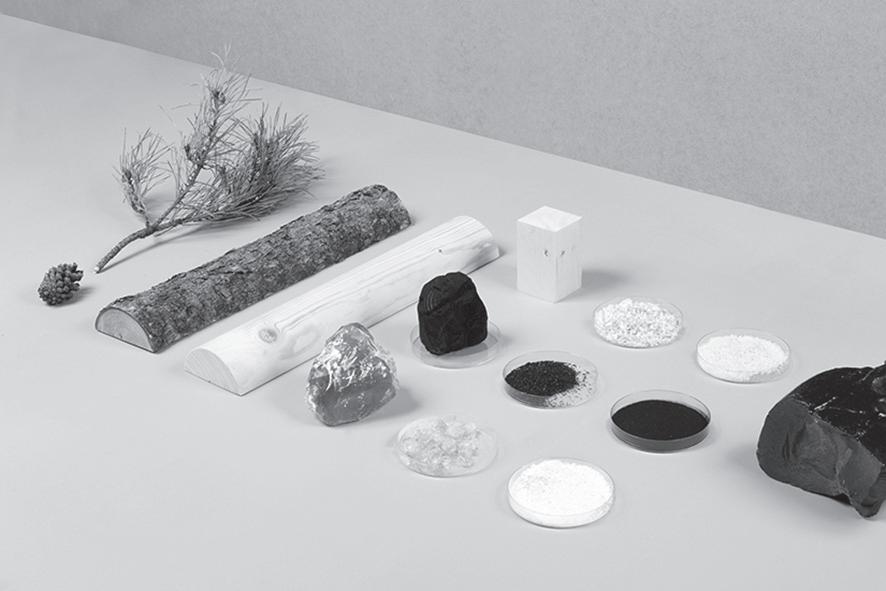
5 minute read
Researched Examples
Researched examples - best practice
1 ) The Paulownia Tree ( 1924 – 2016 ) Villa Le Lac
Advertisement
ECAL / Jaime Hayon
Villa ‘Le Lac’ located on the shore of Lake Geneva in Switzerland, is one of the first examples of modern architecture designed by Le Corbusier and his cousin Pierre Jeanneret. The house was completed in 1924 and became the home for Le Corbusier’s parents.
When ECAL / university of art and design in Lausanne were notified that the historical Paulownia Tree, planted in 1924 on the garden terrace of villa, was to be removed due to an incurable illness, ECAL asked artist and designer Jaime Hayon to honor the site and the architecture, by creating a new work from useable timber salvaged from the tree.
‘I was honored to be given the task to create new objects from the Villa ‘Le Lac’ tree to, in turn, honour the great Le Corbusier,’ explains Jaime Hayon. ‘I thought about who would most miss the beautiful Paulownia standing on the banks of Lake Geneva. I thought about birds singing amidst the sound of leaves in the wind, a little home for those birds, and kids laughing joyously while swinging from the branches. I let this spirit guide me in creating the three objects which speak to the poetic nature of the tree, evoking new life.’
So the Paulownia Tree and Le Corbusier’s memory continues to live in three decorative objects which will be produced from all the healthy parts of the tree, down to the very last piece of wood. The pieces reference the tree that has been cut down, and have a specific functional use, a bird house, and a ledge designed to hold household items.
An offspring from the Paulownia Tree has been replanted at the ‘Bourse aux Arbres’ in the suburbs of Lausanne where it is now more than 1m high.
2 ) Future Library Katie Patterson 2014 - 2114
Through the development of our proposed project Time, we came across this remarkable project by Scottish artist Katie Patterson and we acknowledge an element of creative homage to her literary concept, Future Library.
A forest has been planted in Norway, which will supply paper for a special anthology of books to be printed in one hundred years time. Between now and then, one writer every year will contribute a text, with the writings held in trust until 2114, when the published texts will become a library in a specially designed room in the New Public Deichmanske Library, Oslo.
Tending the forest and ensuring its preservation for the 100-year duration of the artwork finds a conceptual counterpoint in the invitation extended to each writer: to conceive and produce a work in the hopes of finding a receptive reader in an unknown future.
The author, poet, essayist and literary critic Margaret Atwood was the first writer to contribute to the project.
www.futurelibrary.no
3 ) 7000 Oaks Jospeh Beuys 1982 – on going
In 1982, for documenta 7, Beuys proposed a plan to plant 7000 oaks throughout the city of Kassel, each paired with a basalt stone.
The project, seen locally as a gesture towards green urban renewal, took five years to complete and has spread to other cities around the world.
7000 Oaks functions not just literally, in practical environmental terms, but symbolically, as an everyday inspirational image. It embodied, metonymically, Beuys’s utopian and poetic metaphysic of a social sculpture designed to effect a revolution in human consciousness.
By means of its permanence and longevity it also sought to render “the world a big forest, making towns and environments forest-like. For Beuys intended the project as realized in Kassel to be only the first stage in an ongoing scheme of tree planting to be extended throughout the world.
Subsequently, single trees with stones have been placed at strategic sites, including the Fifth Biennale of Sydney, Australia.

https://diaart.org/media/_file/brochures/beuys-joseph-7000-oaks-new.pdf


4 ) Re-configuration of a tree Thomas Vailly 2015
Reconfiguration of a tree is a product design research project, focused on biobased material isolated from the Pinus Pinaster, a resinous tree that can be harvested for it’s resin or pitch.
‘‘Thomas Vaillly took a natural element, the Pinus Pinaster tree, ripped it apart and rearranged its elements into man made materials with as few modifications as possible. These natural materials are building blocks - biopolymers, sticky tar, pitch, flexible fibers or stiff binders. When combined they turn into a man made material. The project has gone back to more basic uses of these natural building blocks to develop new, potentially sustainable materials.”
The result is an abstraction of a tree, black matter joining, coating and contrasting with the raw pine timber. The ingredients are low grade, renewable, biodegradable, materials such as cellulose, lignin, rosin,... In order to reveal the full potential of the tree, the isolated materials were given to artists and designers who , through the exploration of media, with created a series of custom prototypes.

Kate Daw and Stewart Russell
Have been collaborating for the past decade on large scale, public visual art projects. They share a strong interest in bringing other people’s memories, opinions and experiences into the artwork.
They are particularly interested in locating and resurrecting forgotten histories, and working with narrative, politics and site in their practice, as well as engaging the skills, stories and experiences of others directly as both material form and subject in their artwork.
They have completed a major permanent sculpture that took the form of a cast bronze bell and 8m campanile tower (Civic Twilight End, 2010), been shortlisted twice for the Basil Sellers Art Prize (A Simple Act, 2008, Another World, 2016), were the recipients of the inaugural Artist Fellowship at the MCG (Two Homes 2010), their collaborative practice has been acquired by the National Gallery of Victoria and private collections. They deliver lectures about their work nationally and internationally.
Image left: Kate Daw and Stewart Russell, Civic Twilight End, 2010








